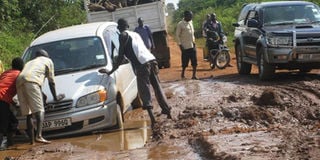Bad state of roads angers Lango

Impassable. Vehicles stuck on a dilapidated road in Apac District last week. Most of the roads in Lango Sub-region are in a bad state. PHOTOS BY BILL OKETCH
What you need to know:
- Today, a journey from Lira Town, Lango Sub-region’s principal trade centre, to Amolatar Town, a 108km distance, takes travellers more than two hours because the entire road is covered with potholes.
- Transporters have also increased fares, saying the bad state of the roads make them incur higher vehicle repair costs, among other excuses.
LANGO. Residents of Lango sub-region have protested the bad state of roads in the sub-region.
The state of the roads have worsened following the ongoing rainy season that has rendered several roads impassable.
Motorists are forced to spend several hours maneuvoering through potholes and slippery roads.
The youth leader of Atek Okwer Ibu clan, Mr Hamza Okello, says: “The number of small broken bridges is increasing and the sub-county leadership has not been able to offer support.”
He adds that the bad state of roads have hindered social and economic activities. “For instance, pupils reach school when they are soaked and wet, patients are dying before reaching health centres, fresh foodstuff are rotting because farmers cannot access markets,” Mr Okello says.
Residents have expressed anger over failure by local government and central government officials to repair roads in the sub-region.
They have threatened to stage demonstrations across the sub-region if the roads are not expeditiously repaired.
There are eight districts in Lango sub-region: Lira, Oyam, Amolatar, Dokolo, Otuke, Kole, Apac and Alebtong.
One of the roads that is in a bad state is the one leading to the ancestral home of former president Apollo Milton Obote.
Some access roads abandoned during the Lord’s Resistance Army rebel insurgency in northern Uganda have become impassable and cannot support redevelopment of the sub-region.
Complaint
“Politicians visit us here only when they are begging for votes or when a very important person dies. But generally, they do not care about us,” Ms Mila Okech, a resident of Aleka Sub-county in Oyam District, says.
Benson Odongo, another resident, says: “Some children have dropped out of school because of fear of the dilapidated roads. When roads are in good shape, it makes it easier for us to move to the market and sell our produce.”
Today, a journey from Lira Town, Lango Sub-region’s principal trade centre, to Amolatar Town, a 108km distance, takes travellers more than two hours because the entire road is covered with potholes.
Transporters have also increased fares, saying the bad state of the roads make them incur higher vehicle repair costs, among other excuses.
The former Member of Parliament for Oyam South in Oyam District, Mr Ishaa Otto Amiza, says dilapidated community roads are only repaired when President Museveni or other very important persons visit.
“I was in Kiryandongo the other day and I saw people busy repairing the road because the President was expected to visit the area to commission a hospital built by Restoration Gateway,” he says.
The youth leader of Atek Okwer Ibu clan suggests: “We need to engage leaders at lower local government levels to prioritise road maintenance. The local council leaders should also engage community members in maintaining access roads.”
President Museveni, while attending Dokolo North Member of Parliament Paul Amoru’s belated thanksgiving ceremony at Adwoki Technical Institute recently, said his government has done well in all sectors.
“I want to thank the people of Lango for voting for the NRM in spite of the lies which are always here. I congratulate you for ignoring the lies and voting for the truth. In much of Uganda, the battle is between lies versus the truth and that has been the situation even before independence,” President Museveni said.
“Now the tarmac roads have been done and more will be done. For instance the one from Rwekunyu via Masindi Port, Apac, Lira, Puranga – all the way to Achol-bur (Kitgum) will be tarmacked,” he said.
President decries laziness
The President said the government had procured good road construction equipment for the districts to repair their roads.
“So, all these are development. However, as I keep telling you, dongo lobo (developing the country) is for all of us. A tarmac road may not remove poverty from your home,” Mr Museveni added.
The President said Africans are poor because they spend too much time sleeping and lazing around.
“Africa is so rich because we have got water, land, minerals, good weather. So, how does this (poverty) come about? It is because of nino (sleeping),” he said.
“People, as the prayer book of the Church of Uganda says, ‘leave undone as they ought to do and they do things that they are not meant to do’. That is why you get poverty in the place which has got a lot of lonyo (wealth),” he added.
Dokolo LC5 chairman Frederick Odongo acknowledges that his administration has done little to repair the dilapidated roads.
“We are currently experiencing a downpour which has made it very difficult for us to repair our horrible roads and the equipment the government has given us are very expensive to maintain. But when the rain reduces, we shall embark on massive road repairs,” he says.
Residents of Apac District say they are disappointed that the work on a key road project has not yet commenced yet the President has assured them the money for the work has been secured.
The road, which is intended to link the five districts of Kiryandongo, Apac, Lira, Pader and Kitgum, is also expected to improve local trade and delivery of social services.
Uganda has one of the poorest road networks in east Africa, according to Development and Cooperation newsletter. The newsletter states that the bad state of roads in Uganda is holding back growth, regional trade and development.
The newsletter states that graft and slow government action concerning procurement and construction are hindering establishment of good road networks in the country.
Tarmacked roads in northern Uganda
Figures obtained from both the Uganda National Roads Authority and district engineering departments in the northern Uganda reveal that despite the region being the biggest of the four regions of the country, with a size of 81,854.1 square kilometres and a population of at least 7,148,139 people, it has only 639km of tarmac. That represents 14.9 per cent of the kilometres of tarmac nationwide. A total of 172kms are located in Acholi sub-region, 214kms in Lango sub-region and 253kms in West Nile.
Some of the tarmac roads in Acholi sub-region include the Gulu-Atiak road (74kms), Atiak-Nimule (35kms), Gulu-Kamdini (63kms) and the Lira-Kamdini road (70kms), which it shares with Lango sub-region.
Those in Lango sub-region are Lira-Abalang on the border with Kaberamaido (Teso) sub-region (48kms) and Lira-Bobi on the border with Acholi sub-region’s Omoro District (96kms).
Nebbi Pakwach (53kms), Nebbi Arua (76kms), Arua Oraba (92kms) and Arua Maracha (32kms) constitute the 253kms of tarmac in West Nile region.




